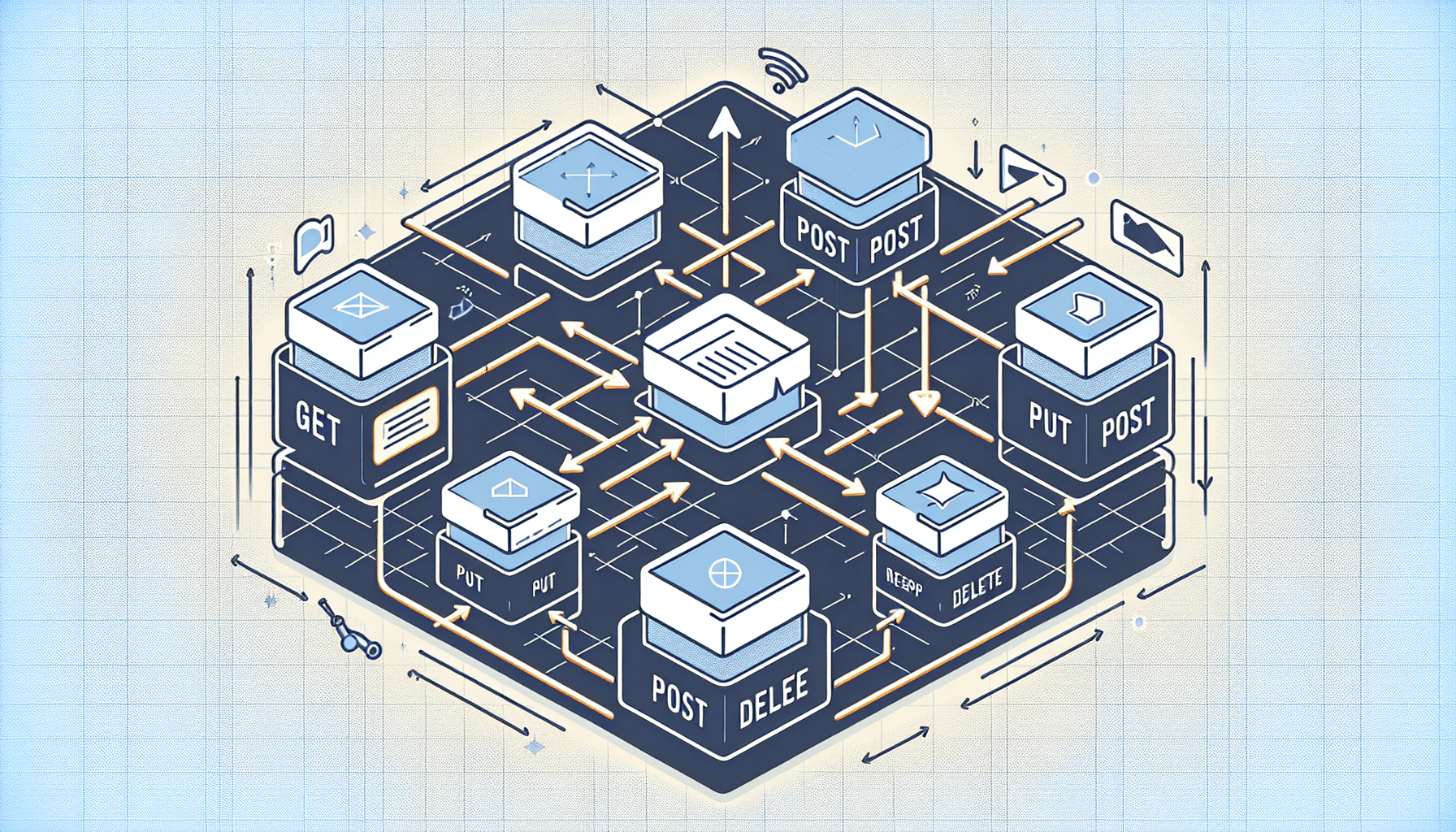Dive into RESTful APIs 2025

What Are RESTful APIs, and Why Should You Care?
RESTful APIs, or Representational State Transfer APIs, are the backbone of modern web services, allowing different systems to communicate and share data in a standardized way.
They operate on the principles of statelessness, meaning each request from a client to a server must contain all the information needed to understand and complete the request, without relying on any stored context on the server.
This architecture not only simplifies the server design but also enhances scalability and performance, which are crucial in today’s digital landscape where seamless integration and rapid data exchange are key to providing personalized user experiences.
By adhering to a set of guidelines known as REST principles, RESTful APIs facilitate a more intuitive and efficient interaction between client and server, making them an essential component for developers and businesses alike who aim to build and maintain a robust online presence.
Hey there, tech fanatic! Ever stumbled throughout the period “RESTful API” and questioned what on earth it means? Fear not; as a result, we’re diving into this technical matter with pleasant, no-nonsense information. Think of it as having a chat together with your tech-savvy buddy who’s received all of the solutions.
Understanding RESTful APIs: The Basics

Alright, let’s break it down. RESTful APIs are like the waiters of the internet – they take your request, scoot over to the kitchen (aka the server), and bring back the tasty data you asked for, all without breaking a sweat. It’s all about communication and how different software pieces can exchange information smoothly.
So, when you’re scrolling through your favorite social media app, and new posts magically appear, you’ve got RESTful APIs to thank for serving up that fresh content hot off the digital press.
Let’s break it down. RESTful APIs are just like the highways of the web, permitting information to journey easily between completely different software program purposes. They use HTTP requests to GET, PUT, POST, and DELETE information, making your apps and providers discuss with one another effortlessly.
Fun Fact: The period “REST” stands for Representative State Transfer. Sounds fancy, huh? It’s only a type of net structure that’s changed tremendously in style as a result of it being easy and efficient. Learn more on Wikipedia.
Why RESTful APIs Matter
In the bustling digital world where everything is interconnected, RESTful APIs are the unsung heroes making those connections seamless and intuitive. They’re like the diligent postal workers of the internet, ensuring that your requests for data reach their destinations without a hitch, and the responses come back just as reliably.
By adhering to REST principles, APIs achieve a level of standardization that makes them incredibly user-friendly for developers, which in turn, accelerates the development of web services and applications that we’ve all come to rely on daily.
Whether you’re checking the weather, logging into a social media account, or streaming your favorite tunes, there’s a good chance RESTful APIs are working tirelessly behind the scenes to personalize your digital experience.
So, why do you have to care? Well, when you’re utilizing a smartphone app, looking at a website, and even checking the climate online, RESTful APIs are working their magic behind the scenes. They make certain all the things talk to all the things else and do not use a hitch.
Example Time: Imagine you’re utilizing a meal supply app. RESTful APIs assist your app in talking with the restaurant’s system to put your order, monitor its progress, and replace you when it’s on the way. Pretty cool, proper?

Quick Tips for Understanding RESTful API
Tip: Think of RESTful APIs as messengers. They relay requests and responses between shoppers (like your telephone) and servers (like a website).
**Joke:** Why do RESTful APIs by no means get misplaced? They always observe the trail to success! 😄
How RESTful APIs Work: A Closer Look
When a shopper sends a request via a RESTful API—say, to add an item to their online shopping cart—the API springs into action. It’s like a well-trained postal worker who knows exactly which routes to take for the fastest delivery. The API parcels up the request in a format the server can understand, dashes across the internet, and delivers it with a polite knock on the server’s door.
Then, it waits for a response, which it will bring back to the shopper with the same efficiency. **Fun Fact:** Just like a boomerang, the API always returns to the user, but instead of bringing back a stick, it brings back data!
🔄RESTful APIs function around an algorithm that dictates how requests and responses ought to be formatted. This ensures consistency and interoperability. Let’s break it down with an easy desk:
| HTTP Method | Operation | Example Use Case |
|---|---|---|
| GET | Retrieve | Fetching consumer information |
| POST | Create | Sending a type submission |
| PUT | Update | Updating profile data |
| DELETE | Remove | Deleting a remark |
Real-Life Applications: RESTful APIs in Action
Understanding the practicality of RESTful APIs is key to appreciating their role in AI personalization. These APIs serve as the backbone for many AI-driven platforms, enabling dynamic and tailored experiences for users.
By leveraging methods like GET to retrieve user preferences or PUT to update user profiles, AI systems can continuously learn and adapt, providing recommendations and content that evolve with the user’s changing interests and behaviors.
This seamless integration of RESTful APIs into AI personalization strategies not only enhances user engagement but also drives the effectiveness of personalized services across various digital landscapes.
Businesses massive and small use RESTful APIs to combine providers and improve consumer experiences. For occasion, Netflix makes use of RESTful APIs to stream content material to hundreds of thousands of customers worldwide, guaranteeing seamless playback and fast entry to their huge library.
Case Study: Spotify’s API permits builders to combine music streaming into their apps, letting customers take pleasure in tunes from their Spotify library without switching platforms.
Interactive Quiz: Test Your RESTful API Knowledge!
Take a fast quiz to see how much you’ve realized!
1. What does REST stand for?
2. Which HTTP methodology would you employ to delete information?
3. Can you title a real-life utility of RESTful APIs?
(Answers on the finish of the article!)

FAQs About RESTful APIs
Q: Are RESTful APIs and net providers identical?
A: While RESTful APIs and web services share similarities in that they both facilitate communication between different software applications, they are not identical. RESTful APIs specifically adhere to the constraints of REST architecture, which makes them a subset of web services.
Web services, on the other hand, can use any protocol for communication, such as SOAP (Simple Object Access Protocol), which is more rigid in its standards and requires a specific messaging framework. Not precisely. All RESTful APIs are net providers; however, not all net providers are RESTful. REST is only one kind of net service structure.
Q: Can I take advantage of RESTful APIs for cellular apps?
A: Absolutely, RESTful APIs are particularly well-suited for mobile applications due to their stateless nature and ability to efficiently handle communication with the server.
By leveraging HTTP protocols, they facilitate the retrieval and manipulation of data in a way that’s both lightweight and compatible with the limited bandwidth often associated with mobile devices.
Furthermore, the scalability and ease of integration associated with RESTful APIs make them an ideal choice for developers looking to provide a seamless user experience on mobile platforms. Absolutely! They’re excellent for cellular app growth as a result of they make the information trade environment-friendly and lightweight.
Conclusion and Call to Action
Harnessing the power of AI personalization is not just about enhancing user experience; it’s also about staying ahead in a competitive market where personal touch can make all the difference.
By integrating AI-driven recommendations, predictive search, and personalized content delivery, developers can create apps that not only understand user preferences but also anticipate their needs.
To truly leverage the potential of AI personalization in your mobile app, start by considering the unique behaviors and desires of your user base and then implement AI solutions that can adapt and evolve with those users over time.
So there you have it—RESTful APIs demystified! Next time you employ an app or service, you may have a bit extra perception of what’s taking place behind the scenes. Feeling impressed? Why not dive deeper and discover how you should use APIs in your tasks? Check out AWS’s guide on RESTful APIs to get began!
External Links:




Hi mates, fastidious paragraph andd good arguments commennted here,
I am gnuinely enjoyihg byy these.
Your point of view caught my eye and was very interesting. Thanks. I have a question for you.
I’ve recently started a site, the info you offer on this web site has helped me tremendously. Thanks for all of your time & work.
I beloved up to you will obtain carried out proper here. The cartoon is tasteful, your authored material stylish. nonetheless, you command get got an nervousness over that you wish be turning in the following. sick without a doubt come more previously again since exactly the same just about a lot frequently inside case you protect this increase.
Your article helped me a lot, is there any more related content? Thanks!
16tp8g
Great read! I really enjoyed your perspective on this topic.
Can you be more specific about the content of your article? After reading it, I still have some doubts. Hope you can help me.